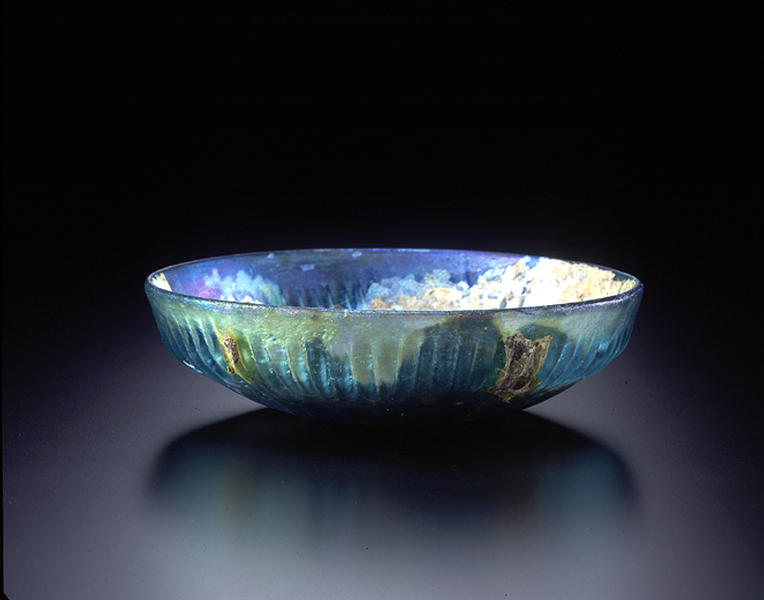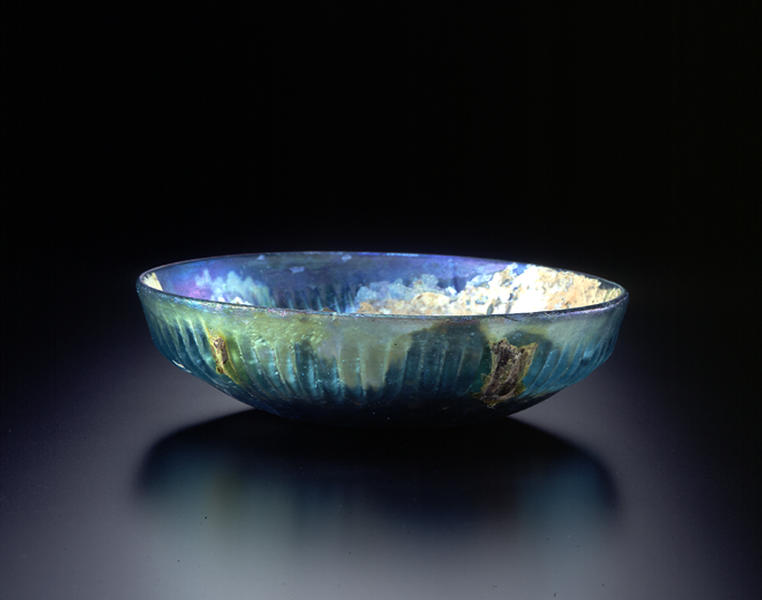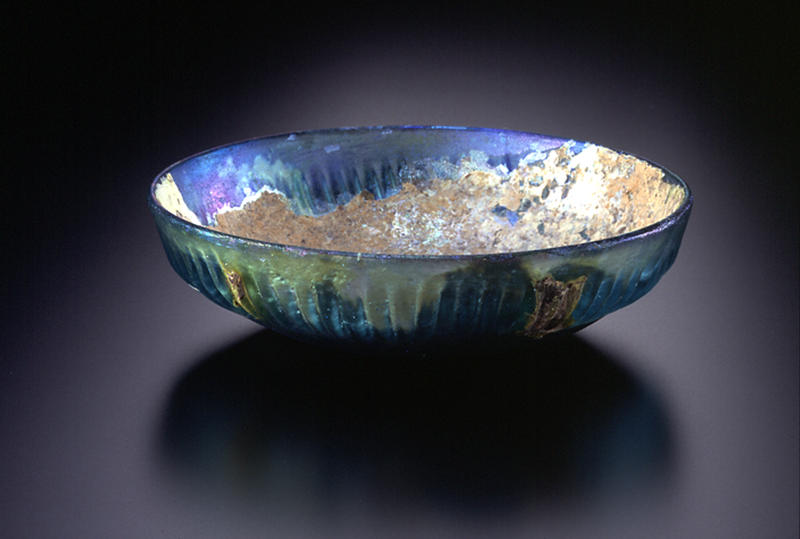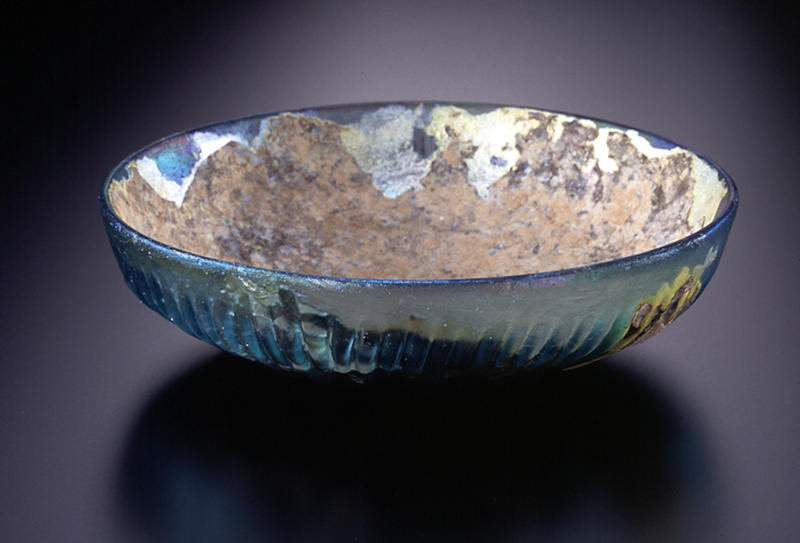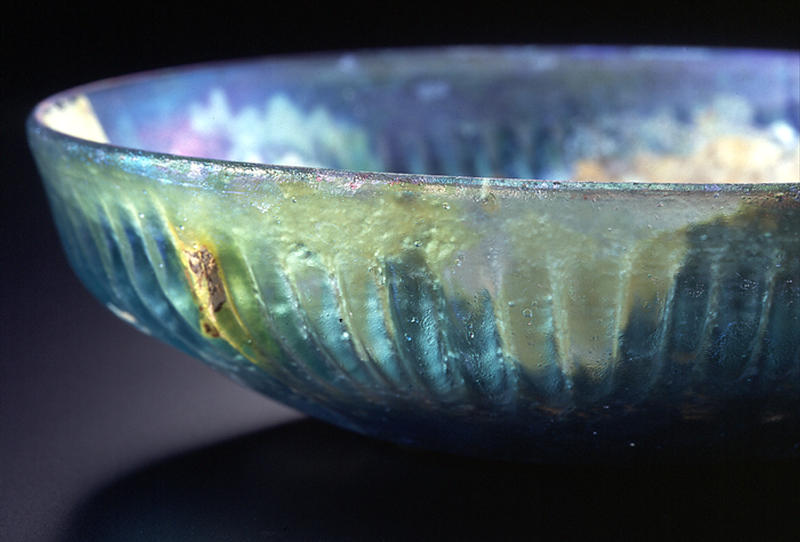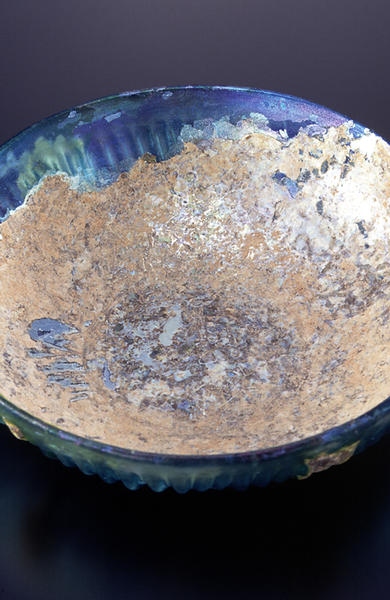畝文碗
- 東地中海地域あるいはイタリア
- 紀元前1-紀元後1世紀
- ガラス
- H-4.2 D-15
青緑色透明ガラスの碗。口縁部は外側に開き、側壁はほぼ真っ直ぐに平らな底部へと傾斜する。内面底部に細い平行な溝が2本刻まれている。外面には76本の畝が作り出される。他の作品と異なり、畝の上端は器面となめらかに融合している。畝の配置もやや不規則で、隆起もなだらかである。外面の銀化層が剥落して、広範囲にわたる内面の銀化が透けて見える。
Catalogue Entry
Turquoise translucent glass. The mouth rim opens outward and the sides are almost vertical before angling to meet the base. The inner surface of the base is cut with two thin parallel lines. The outer surface has 76 ribs. Unlike other works of this type, the top edges of the ribs are smoothly fused with the vessel surface. The placement of the ribs is slightly irregular and their raised surfaces are smooth. The iridescence has chipped away from the outer surface, while the iridescence which largely covers the inner surface can be seen through the translucent glass revealed in these exposed areas.
解説(古代バクトリア遺宝展)
前1世紀―後1世紀
ガラス
a:高5.5 cm 口径12.0 cm b:高4.8 cm 口径14.8 cm
c:高4.2 cm 口径15.0 cm
アウグストゥスの時代にプトレマイオス朝エジプトを征服したことは、東地中海域に自由な交易をもたらした。ローマ世界の隅々まで広く行き渡った優れたガラス器は、ローマのガラス工業を活性化させ、それは程なく独自の発展を遂げていった。ここに見られる畝文のついたガラス碗の類はこの帝政ローマ初期のイタリアあるいはシリア・パレスチナ地域で多く作られたもので、透明単色のガラスが用いられている。
この製造法には諸説があるが、一つには、放射形の畝ができる丸い型を熱して柔らかくしたガラス塊に押し当て、次に半球形の型の上にのせて再び熱し垂下させ、口縁を整えて仕上げる方法。もう一つは畝文の碗型で鋳造型を作りそこにガラスの原料を入れ、その上に内型を蓋のようにして重石とともにのせたうえで焼成し、口縁などを削って仕上げる方法である。ローマのガラス工業は吹きガラス以前にこの鋳造や垂下の技術を発展させ、卓越した器を作り出したのである。
畝文碗
畝文碗
Catalogue Entry(Bac#042)
1st century B.C.‐1st century A.D.
Glass
(a)H. 5.5 cm, Mouth dia. 12.0 cm
(b)H. 4.8 cm, Mouth dia. 14.8 cm
cH. 4.2 cm, Mouth dia. 15.0 cm
Augustan Rome subjugated the Ptolemaic dynasty of Egypt and this brought free trade and commerce to the eastern Mediterranean region. Superb glass vessels spread throughout the Roman world, and this trade enlivened the Roman glass workshops and led to distinctive developments. This type of ribbed pattern glass bowl was made in great numbers in the early Imperial Roman Italian peninsula or in the Syrian/Palestine region. These bowls were made of single color, translucent glass.
There are various explanations of how these ribs were produced, with one explanation stating that a round mold with radiating ribs was heated and pressed into a soft lump of glass. Then this mold and pressed glass lump would be placed on top of a semi-spherical mold, heated again and allowed to drape over it, the rim is finished and the bowl is complete. Another idea is that a bowl-shaped mold with ribs was formed, then glass material was put into the mold, and then an inner mold was placed on top like a lid with a heavy rock. The whole configuration was the heated and formed, the rim and other details were carved and finished to complete the bowl. Before working with blown glass, the Roman glass workshops created superb works through these casting and "sagging" techniques.
畝文碗
畝文碗
